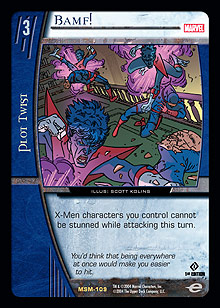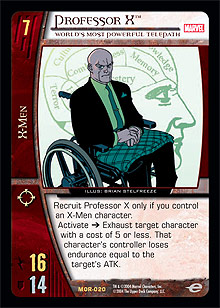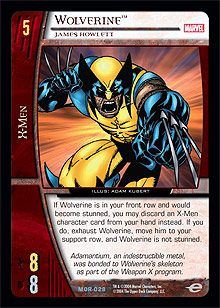Every once in a while, it's fun to go through the archives at Metagame.com and find some of those $10K Top 8 decks that didn't get as much attention as they might have. Look, for instance, at $10K Columbus in February 2005. At the time, only four sets had been released: Marvel Origins, DC Origins, Web of Spider-Man, and Superman: Man of Steel. There were teams that saw play and teams that didn't, but perhaps the most disappointing team of the first four sets was the X-Men. They had a fairly good showing at the second Pro Circuit, but that was with a deck based around Puppet Master, so X-Men fans looked on it as an abomination. When would a true X-Men deck take the field and bring home the bacon?
As it turned out, the X-Men's true colors would fly on a cold February day in the hands of Aaron Breider. Aaron was well-known as an X-Men devotee, and in Ohio's capital he was able to bring the mutants to a long-awaited Top 8.
Aaron Breider
X-Men
$10K Columbus, February 2005
Characters
4 Nightcrawler, Kurt Wagner
 2 Bishop, Lucas Bishop
2 Bishop, Lucas Bishop
4 Wolverine, Logan
2 Havok, Alex Summers
4 Rogue, Power Absorption
3 Rogue, Powerhouse
4 Wolverine, James Howlett
1 Archangel, Angel of Death
4 Colossus, Peter Rasputin
3 Professor X, World’s Most Powerful Telepath
3 The Demon, Etrigan
Plot Twists
4 Savage Beatdown
2 Shape Change
4 Total Anarchy
4 Combat Reflexes
4 Bamf!
2 Children of the Atom
Locations
4 Cerebro
2 Madripoor
$10K Columbus was the beginning of the Curve Sentinels era in Golden Age. While Curve Sentinels had finished well at Pro Circuit Los Angeles, it had not cracked the Top 8, and its previous 2nd place finish at $10K Wizard World Texas was seen as something of a fluke. Teen Titans was still considered to be the best deck in the game, and Gabe Walls proved it in Columbus by winning the tournament with it. Common Enemy and the Brotherhood were still around as well, and Jason Hager shocked the world with his 2nd place finish with a deck later known as Evil Medical School. Among this Top 8, which featured quite a few well-known players and decks, Aaron's X-Men deck was slightly outshined.
Aaron plays at RIW Hobbies in Livonia, Michigan—which is also home to such Vs. System luminaries as Michael Jacob, Kyle Dembinski, and Dan Clark—and this deck shows the type of creative deckbuilding and problem-solving that the store has become known for. For deckbuilders who like to solve problems, the X-Men certainly presented a challenge; there were several things the X-Men needed to do well in order to become a force in Golden.
One of the main problems was that at most later drops, the X-Men were just a bit sub-par. They had the amazing Wolverine, Logan on turn 3, and Rogue, Power Absorption was suitable on turn 4 even if she had no powers she could copy, but the 5-drop and 6-drop were just a bit thin. Wolverine, James Howlett was easily their best 5-drop, but he conflicted with Logan on turn 3. Archangel, Angel of Death certainly helped, but James Howlett was an amazing tool against aggressive decks. Colossus, Peter Rasputin was a great 6-drop if one could get the required five X-Men characters into the KO'd pile, but the average X-Men deck had difficulty doing that if it didn't hit Cerebro.
Another problem was that while the X-Men tended to be a controlling team, the necessary cards did not exist to build a successful control deck with just X-Men-stamped cards. The X-Men had plenty of characters that were meant for that control strategy, but to actually win games, the X-Men had to be able to compete on the field of battle. This led to a strange dual focus for X-Men: control the board with character effects, but also control the board with character combat. This is a hard thing for any deck to pull off, and the X-Men deck was no exception.
 Aaron, however, managed to find the right balance to deal with the majority of the X-Men's problems. The X-Men could do well when they made it to the late game. Professor X, World's Most Powerful Telepath is still one of the top five 7-drops in the game, and if Rogue, Power Absorption could make it to turn 7, the X-Men could put a lot of pressure on most decks. Since the deck couldn't use Jean Grey, though, all that control didn't lead up to much. The usual 8-drop of choice at the time was Apocalypse, but Aaron found a much more interesting and creative answer for his 8-drop: The Demon, Etrigan. Aside from the awesome game text, The Demon, Etrigan had an interesting caveat: if an opponent didn't have 8 endurance to pay, he or she lost all his or her resources automatically. By taking evens, this deck could usually have its opponent near enough to 0 endurance that he or she would be deprived of all resources—and this effect happened before he or she could play anything on turn 8. If the opponent wasn't below 8, an X-Men player could use Professor X on his or her build step before playing The Demon if necessary. This was more than enough of an advantage for the X-Men to win the game.
Aaron, however, managed to find the right balance to deal with the majority of the X-Men's problems. The X-Men could do well when they made it to the late game. Professor X, World's Most Powerful Telepath is still one of the top five 7-drops in the game, and if Rogue, Power Absorption could make it to turn 7, the X-Men could put a lot of pressure on most decks. Since the deck couldn't use Jean Grey, though, all that control didn't lead up to much. The usual 8-drop of choice at the time was Apocalypse, but Aaron found a much more interesting and creative answer for his 8-drop: The Demon, Etrigan. Aside from the awesome game text, The Demon, Etrigan had an interesting caveat: if an opponent didn't have 8 endurance to pay, he or she lost all his or her resources automatically. By taking evens, this deck could usually have its opponent near enough to 0 endurance that he or she would be deprived of all resources—and this effect happened before he or she could play anything on turn 8. If the opponent wasn't below 8, an X-Men player could use Professor X on his or her build step before playing The Demon if necessary. This was more than enough of an advantage for the X-Men to win the game.
Aaron also dealt creatively with some of the other problems inherent to the deck. Total Anarchy is a card that helped the X-Men get to the late game that they played so well, but it also evened the playing field a little for Wolverine. It was much fairer to KO one’s 3-drop to play a 5-drop if the opponent's 3-drop was already KO’d to Total Anarchy. Thanks to Anarchy, the X-Men could play the full four of both Logan and James Howlett. This advantage led to the shoring-up of another disadvantage: the weakness of Colossus, Peter Rasputin when the X-Men player didn't have a KO’d pile full of characters. With eight copies of Wolverine and an additional seven copies of Rogue, the deck’s wielder could power-up to his or her heart's content. The maximizing of Colossus also led to another interesting choice, Shape Change. In most decks this card would be Acrobatic Dodge because the bonus is a reliable -3 ATK / +3 DEF. With this deck, the controller wanted that extra card to go to the graveyard to power Colossus up, and since there were so many high-cost cards in the deck, the character might get -6 ATK / +6 DEF or more, and brickwall an attack that Acrobatic Dodge would not have.
The deck features four copies of Bamf!. As I said above, this deck needed to be able to dominate combat to truly succeed, and no card lets you dominate an attack step quite like Bamf!. With eight combat pumps in the deck—including four copies of the underrated Combat Reflexes—Bamf! virtually guarantees a favorable attack step. The best time to play it is turn 6, when it's likely that the X-Men player will have Rogue, Power Absorption; Wolverine, James Howlett; and Colossus, Peter Rasputin to decimate the opponent's board position.
 There's not much in the way of finesse here. Aaron took a team, used the cards available within the theme, and created the tightest decklist he could. Then he played that deck flawlessly and won $500 . . . with a deck no one thought could compete. Aaron was able to identify what was important to the team—such as Wolverine, James Howlett—and build a deck that took advantage of its own strengths.
There's not much in the way of finesse here. Aaron took a team, used the cards available within the theme, and created the tightest decklist he could. Then he played that deck flawlessly and won $500 . . . with a deck no one thought could compete. Aaron was able to identify what was important to the team—such as Wolverine, James Howlett—and build a deck that took advantage of its own strengths.
Most importantly, though, Aaron Breider is a very, very good player. If there's any lesson rogue deckbuilders can take away from the X-Men's triumph, it's that Aaron's talent as a Vs. System player—and not necessarily his deck—was the reason for his success. While this is the best X-Men list anyone probably could have come up with at the time, what really got Aaron to the Top 8 in this 150-man tournament was his own play skill. In general, the less powerful your deck is, the better your play skill has to be. I actually got to watch several of Aaron’s matches in person (for obvious reasons, his matches were popular matches to watch), and I didn't see a single mistake.
So, rogue deckbuilders, remember that deckbuilding is only one part of the equation. Vs. System is the gamers' game; it rewards sharp play more than any other TCG. While you're building the next rogue deck, spend some time working on the way you play the game. Was that the right attack? Should you reinforce there or not? Should you play this character or that character? Take some time as you're playing to reflect on the plays you're making. Ask the advice of bystanders and, if you're just playing casually, your opponent. They might clue you in to a better play or a fatal flaw in your plan. Don't just figure out the right play; figure out what makes it right. You may be able to build the best deck, but if you can't play the best deck, you'll never find out just how good your creation was.
Until next time,
Mark Slack
ms243@evansville.edu